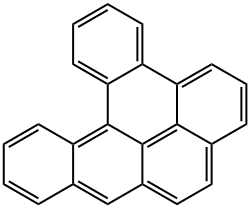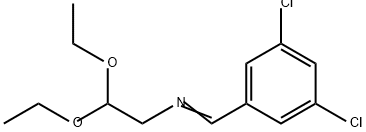Chemical Properties
Yellow Solid
Uses
An active metabolite from inhalation and dermal exposure to polycyclic aromatics hydrocarbons in hot mix asphalt paving workers. DBC is the most potent tumorigen that has been identified to date.
Dib
enzo[def,p]chrysene (DBC) is a carcinogen and should be handled with appropriate caution.
Definition
ChEBI: Dibenzo[a,l]pyrene is an ortho- and peri-fused polycyclic arene. It has a role as a mutagen and a human metabolite.
General Description
Yellow odorless crystals or flakes. Water insoluble.
Air & Water Reactions
Dust/air mixtures may ignite and explode. Insoluble in water.
Reactivity Profile
Vigorous reactions, sometimes amounting to explosions, can result from the contact between aromatic hydrocarbons, such as DIBENZO(A,I)PYRENE, and strong oxidizing agents. They can react exothermically with bases and with diazo compounds. Substitution at the benzene nucleus occurs by halogenation (acid catalyst), nitration, sulfonation, and the Friedel-Crafts reaction.
Safety Profile
Confirmed carcinogen
with experimental tumorigenic data. When
heated to decomposition it emits acrid
smoke and irritating fumes.
Carcinogenicity
Dibenzo[a,1]pyrene is a class
2B carcinogen according to the IARC, although recent
data suggest that it is a 2A carcinogen. In mouse studies,
it has been more potent than benzo[a]pyrene in skin, and in
rat studies, it has been more potent than 7,12-dimethylbenz
[a]anthracene in the mammary gland. Dibenzo[a,l]pyrene
was tested for carcinogenicity in studies of single and
repeated dermal application to mice, as well as several
initiation–promotion studies on mouse skin; all studies
gave positive results. Dibenzo[a,l]
pyrene also induced oral cavity tumors when applied dermally
to the tongue of hamsters and lung tumors in
mice following intraperitoneal injection. In addition
to lung tumors, dibenzo[a,l]pyrene induced hepatic
tumors and a variety of tumors at other sites when administered
intraperitoneally to newborn mice. Multiple
tumor sites were also observed following intragastric application
of dibenzo[a,l]pyrene in mice. Intramamillary
administration to rats also yielded positive results.
Furthermore, two studies on fish demonstrated that nonmammalian
species are also susceptible to dibenzo[a,l]pyreneinduced
tumorigenicity.The most active metabolite
is the potent 11,12-dihydrodiol of dibenzo[a,1]
pyrene.
Toxics Screening Level
The initial risk screening level and secondary risk screening level (SRSL) for benzo(a)pyrene (B(a)P) are 6E-4 μg/m3 and 6E-3 μg/m3, respectively.



